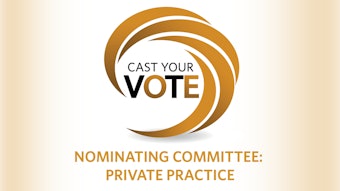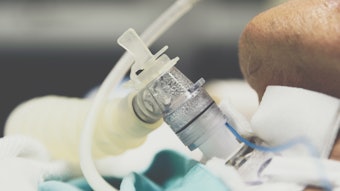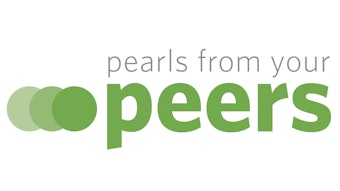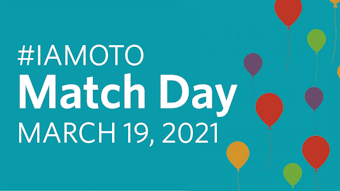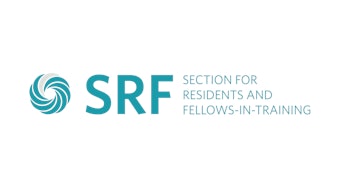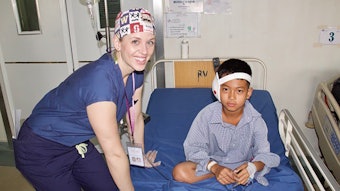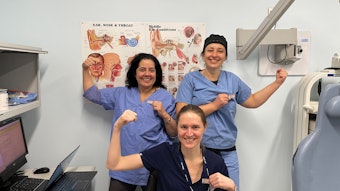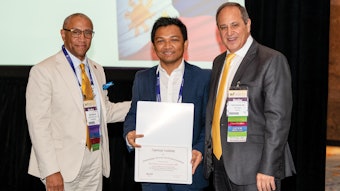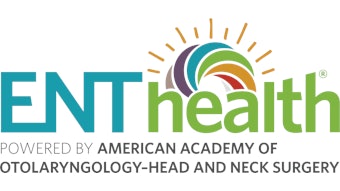Out of Committee: Patient Safety and Quality Improvement | Improving Safety by Studying Why Things Go Terribly Right
Do humans cause patient harm, or do we prevent it?
Ellen S. Deutsch, MD, MS, PSQI Committee member

Like the note on the stop sign in the photograph to the right, sometimes looking at our activities from a different perspective can change our understanding, and a fresh perspective might increase our appreciation for the work that we do every day to optimize patient safety.
Safety-I
The traditional perspective on patient safety, Safety-I, is generally based on the belief that we should investigate healthcare events in which patients were harmed, figure out what failed, and build in barriers to prevent recurrence. When there is an unwanted outcome, we expect to find breaches in protocols or other defenses that caused—or at least allowed—the problem to occur. Humans are often seen as a liability or hazard, and we expect optimal outcomes if processes are standardized and healthcare workers behave as trained.4,5 However, patients may not do well despite our most learned and skilled efforts, and patients sometimes do well for reasons that we don’t completely understand. There is a complementary perspective, Safety-II, which seeks to learn from what went right, acknowledges complexity, and values adaptation.
Safety-II
The majority of patient care interactions go well. This is not to say that we shouldn’t always look to improve and recognize our shortcomings, but there can also be value in understanding and augmenting successful processes. The Safety-II perspective advocates for deliberate investigation to understand what decisions, actions, or adaptations contributed to successful patient outcomes.4 Understanding whether the desired outcome resulted from our ability and effort, rather than from luck,6 can help improve care going forward.
What can we learn from studying what went well? Examples from other fields are never quite sufficient, but still may offer perspective. K. Anders Ericsson, famous for describing the importance of deliberate practice to achieve expert performance, posits that improvement is based not just on repetition, but also requires explicit exposure to the best method.7 Shmuel Ellis and Inbar Davidi found the performance of soldiers who were debriefed on their successes as well as their failures during successive navigation exercises showed greater improvement than soldiers who reviewed their failed events only.6 This makes sense in healthcare also, such as when developing surgical skills. Learners (all of us!) need to understand what we have done right as well as what we may need to improve. This understanding of what went well goes beyond the kudos received for an extraordinary job well done and involves an effort to learn why.
Safety-II also posits that adaptation—performance adjustment—is both necessary and ubiquitous.4 We provide healthcare despite work conditions that are both dynamic and underspecified. The impact of factors that can impair performance may be momentary but recurrent, including competing demands, production pressure, and resource limitations. Successful patient care results from innumerable small adjustments, often unrecognized, or, in rigid systems, accomplished surreptitiously. In this perspective, humans are not liabilities to be managed, but are important resources who contribute to system flexibility and resilience.4
Although not always explicitly recognized, many organizations have responded to the COVID-19 pandemic with behaviors that exemplify Safety-II and resilience engineering principles. Providers have self-organized groups that convene by video conference call and share information about process improvements and lessons learned to proactively minimize risk and improve safety for both patients and providers. Organizations have implemented simulations to develop and revise patient care protocols, refine methods to correctly don and doff personal protective equipment, and enhance communication between providers despite physical barriers necessitated by isolation practices.8
Safety-II Is a Frame Shift
Maintaining a Safety-II perspective, which reinforces correct decisions and actions, sometimes takes conscious effort. For example, when debriefing participants in simulations, it is easy to criticize whereas seeking to surface and understand tacit knowledge and constructive actions often requires intentional reorientation.
The Safety-II approach is also applicable to ordinary processes. It can be difficult to expend energy understanding everyday activities in addition to exceptional successes or failures; however attention to commonplace processes, because of their frequency, may provide the greatest benefit.
Finally, consistently modeling respect and appreciation for colleagues’ actions and perspectives provides an affective lesson; and learning from success can help us appreciate the value of system capacities and resources that might otherwise be lost in efforts to constrain costs.
Safety-I and Safety-II Can Co-Exist
Can these different approaches be reconciled? Healthcare delivery is a complex adaptive system; interactions and conditions constantly evolve and are incompletely knowable. The Safety-I approach of fixing each part of a system in a mechanistic fashion does not always guarantee that the whole will work as desired, but there are circumstances in which standardized protocols are optimal. Conversely, there are inevitable gaps between idealized “work-as-imagined,” which often informs policy, and actual “work-as-done,”4,9 which is the experience of providers at the “sharp end.” We can seek to improve by understanding and appreciating the knowledge, skills, behaviors, resources, and environments that contribute to success, and by recognizing the value of adaptive solutions. The Safety-II approach helps develop resilient capacities that support continued and safe healthcare delivery despite small or large perturbations.10 Healthcare delivery involves unique high-hazard processes, and the complementary perspectives of Safety-I and Safety-II can both contribute to providing the safest patient care.
References
1. Dzau VJ, Shine KI. Two Decades Since To Err Is Human Progress, But Still A "Chasm." JAMA. 2020;324(24):2489-2490.
2. AHRQ national scorecard on hospital-acquired conditions. Agency for Healthcare Research and Quality Web site. https://www.ahrq.gov/hai/pfp/index.html. Updated 2020. Accessed 18Feb2021.
3. National healthcare quality and disparities report chartbook on patient safety. AHRQ Pub. No 21-0012 ed. Rockville, MD: Agency for Healthcare Research and Quality; 2021.
4. Hollnagel E, Wears R, Braithwaite J. From safety-I to safety-II: A white paper. The Resilient Health Care Net. U Southern Denmark, U Florida, and Macquarie U. 2015.
5. Cook R, Rasmussen J. "Going solid": A model of system dynamics and consequences for patient safety. Qual Saf Health Care. 2005;14(2):130-134.
6. Ellis S, Davidi I. After-event reviews: Drawing lessons from successful and failed experience. J Appl Psychol. 2005;90(5):857-871.
7. Ericsson KA. Deliberate practice and acquisition of expert performance: A general overview. Acad Emerg Med. 2008;15(11):988-994.
8. Daly Guris RJ, Elliott EM, Doshi A, et al. Systems-focused simulation to prepare for COVID-19 intraoperative emergencies. Pediatric anesthesia. 2020;30(8):947-950. doi: 10.1111/pan.13971.
9. Patterson M, Deutsch E, Jacobson L. Simulation: Closing the gap between work-as-imagined and work-as-done. In: Braithwaite J, Wears RL, Hollnagel E, eds. Resilient health care III: Reconciling work-as-imagined and work-as-done. Routledge; 2017:143-152.
10. Wears RL, Hollnagel E, Braithwaite J. Resilient health care vol. 2: The resilience of everyday clinical work. Abingdon, Oxon: Ashgate; 2015.




